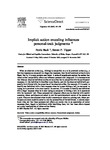Implicit action encoding influences personal-trait judgments.
| dc.contributor.author | Bach, P | en |
| dc.contributor.author | Tipper, SP | en |
| dc.date.accessioned | 2012-05-24T12:22:31Z | |
| dc.date.available | 2012-05-24T12:22:31Z | |
| dc.date.issued | 2007-02 | en |
| dc.identifier.issn | 0010-0277 | en |
| dc.identifier.uri | http://hdl.handle.net/10026.1/1019 | |
| dc.description.abstract |
When an observed action (e.g., kicking) is compatible to a to be produced action (e.g., a foot-key response as compared to a finger-key response), then the self-produced action is more fluent, that is, it is more accurate and faster. A series of experiments explore the notion that vision-action compatibility effects can influence personal-trait judgments. It is demonstrated that when an observed individual carries out an action that is compatible with the participants' response, (1) this individual is identified more fluently, and (2) the observed individual's personality is attributed with the properties of the observed action. For example, if it is easier to identify one individual with a foot-response when he is seen kicking a ball, as compared to typing, he is perceived to be more 'sporty'. In contrast, if it is easier to identify one individual with a finger response when he is seen typing as compared to kicking a ball, he is associated with the 'academic' trait. These personal-trait judgment effects can be observed with explicit measures, where participants are asked to rate the sporty/academic nature of the person on a scale. They are also obtained when implicit measures are taken in a priming task, where participants are never explicitly asked to rate the personalities of the individuals. A control experiment rules out that these personal-trait effects are merely due to an association of motor responses (foot, finger) to individuals while identifying them, but that these effects depend on a prior manipulation of vision-action fluency. | en |
| dc.format.extent | 151 - 178 | en |
| dc.language | eng | en |
| dc.language.iso | eng | en |
| dc.subject | Adolescent | en |
| dc.subject | Adult | en |
| dc.subject | Female | en |
| dc.subject | Humans | en |
| dc.subject | Judgment | en |
| dc.subject | Male | en |
| dc.subject | Psychomotor Performance | en |
| dc.subject | Reaction Time | en |
| dc.subject | Visual Perception | en |
| dc.title | Implicit action encoding influences personal-trait judgments. | en |
| dc.type | Journal Article | |
| plymouth.author-url | https://www.ncbi.nlm.nih.gov/pubmed/16457795 | en |
| plymouth.issue | 2 | en |
| plymouth.volume | 102 | en |
| plymouth.publication-status | Published | en |
| plymouth.journal | Cognition | en |
| dc.identifier.doi | 10.1016/j.cognition.2005.11.003 | en |
| plymouth.organisational-group | /Plymouth | |
| plymouth.organisational-group | /Plymouth/REF 2021 Researchers by UoA | |
| plymouth.organisational-group | /Plymouth/REF 2021 Researchers by UoA/UoA04 Psychology, Psychiatry and Neuroscience | |
| plymouth.organisational-group | /Plymouth/Research Groups | |
| plymouth.organisational-group | /Plymouth/Research Groups/Centre for Brain, Cognition and Behaviour (CBCB) | |
| plymouth.organisational-group | /Plymouth/Research Groups/Centre for Brain, Cognition and Behaviour (CBCB)/Brain | |
| dc.publisher.place | Netherlands | en |
| dcterms.dateAccepted | 2005-11-21 | en |
| dc.rights.embargoperiod | Not known | en |
| rioxxterms.versionofrecord | 10.1016/j.cognition.2005.11.003 | en |
| rioxxterms.licenseref.uri | http://www.rioxx.net/licenses/all-rights-reserved | en |
| rioxxterms.licenseref.startdate | 2007-02 | en |
| rioxxterms.type | Journal Article/Review | en |


